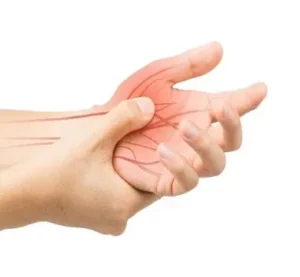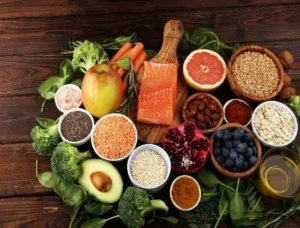Pathways of Pain: A Look at Neuropathy & Nerve Health
 Each second, a vast network of specialized nerve cells sends billions of signals throughout our body as tiny pulses of electricity— with some of these messages traveling up to speeds of 248 miles per hour. Carrying data between our brain, muscles, organs, skin, and glands, our nervous system guides our response to the world around us—our thoughts, sensations, memories, and movements. Nerves also play a vital role in our body’s automatic systems— those things we do without thinking—like breathing, healing, aging, and digesting.
Each second, a vast network of specialized nerve cells sends billions of signals throughout our body as tiny pulses of electricity— with some of these messages traveling up to speeds of 248 miles per hour. Carrying data between our brain, muscles, organs, skin, and glands, our nervous system guides our response to the world around us—our thoughts, sensations, memories, and movements. Nerves also play a vital role in our body’s automatic systems— those things we do without thinking—like breathing, healing, aging, and digesting.
When our nerves are damaged or destroyed, they can’t effectively relay these essential messages, and this malfunction can trigger painful numbness, tingling, weakness, and burning. According to the Cleveland Clinic, the disorders and dysfunctions resulting from damaged nerves—known collectively as neuropathy—impact an estimated 25% – 30% of Americans at some point in their lives.
A Tale of Two Systems
Our body’s nervous system comprises two main parts: the central nervous system (CNS) and the peripheral nervous system (PNS). The CNS is the body’s processing center and includes the brain and spinal cord. The PNS is the network of nerves outside of the brain and spinal cord, and includes sensory, motor, and automatic nerves. These peripheral nerves relay vital signals between the brain and spinal cord and the rest of the body— controlling everything from voluntary movement to sensory information to involuntary functions like breathing, heartbeat, and blood flow. When peripheral nerves are damaged and their signaling capabilities are compromised, many of our body’s most complex functions are impacted.
Peripheral Pain
 The most common form of neuropathy, peripheral neuropathy affects more than 20 million Americans, according to the National Institutes of Health. There are more than 100 types of peripheral neuropathy, and each type has is own set of symptoms and prognosis. The most common symptoms include severe pain, throbbing, numbness, burning and tingling sensations, cramping, coordination loss, and muscle weakness. Ranging from mild to debilitating, peripheral neuropathy symptoms can develop suddenly over days or more gradually over months and years.
The most common form of neuropathy, peripheral neuropathy affects more than 20 million Americans, according to the National Institutes of Health. There are more than 100 types of peripheral neuropathy, and each type has is own set of symptoms and prognosis. The most common symptoms include severe pain, throbbing, numbness, burning and tingling sensations, cramping, coordination loss, and muscle weakness. Ranging from mild to debilitating, peripheral neuropathy symptoms can develop suddenly over days or more gradually over months and years.
Symptoms vary depending on the type of nerve fibers damaged—either motor, sensory or automatic. Our motor nerves control our voluntary muscle movements like standing, walking, or talking; while our sensory nerves relay feelings like temperature and pain; and our automatic nerves control our organs and regulate bodily functions that happen without us thinking about them. Most types of peripheral neuropathies affect each of the three nerve fibers in some way—with some neuropathies primarily affecting one or two types of nerve fibers.
While nerve damage can result from thousands of different conditions, the leading cause of peripheral neuropathy in the United States is diabetes. According to the Cleveland Clinic, nearly 50% of the 30
million Americans suffering from diabetes have some form of nerve damage. Diabetes-related neuropathy typically affects the arms, legs, hands, feet, fingers, and toes. Lupus is also among the diseases commonly linked to neuropathy—with 15% of the 1.5 million American suffering from Lupus affected by nerve damage, according to the Cleveland Clinic.
In addition to damage resulting from disease, nerves can be crushed or severed during a traumatic accident, or pinched to the point of malfunction by detrimental pressure. Blood disorders, infection, exposure to toxins, certain cancers and chemotherapy drugs, nutritional or vitamin imbalances, metabolic issues, and certain inherited disorders are all common causes of nerve damage.
Healthy Habits
 To prevent peripheral neuropathy, it’s important to partner with your doctor to effectively manage and treat any condition or disease, like diabetes, known to cause neuropathy. In addition, you can keep your nerves healthy by exercising regularly, eliminating exposure to toxins, reducing the possibility of injuries, avoiding positions and motions that compress nerves, and adopting a diet rich in whole grains, fruits, vegetables, and lean proteins.
To prevent peripheral neuropathy, it’s important to partner with your doctor to effectively manage and treat any condition or disease, like diabetes, known to cause neuropathy. In addition, you can keep your nerves healthy by exercising regularly, eliminating exposure to toxins, reducing the possibility of injuries, avoiding positions and motions that compress nerves, and adopting a diet rich in whole grains, fruits, vegetables, and lean proteins.
To learn more about Anodyne’s integrated, collaborative approach to treating neuropathy, visit https://anodynepain.com/ today.
Related Articles
Whether you’re struggling to diagnose a chronic pain condition or you’re pursuing wellness treatments to stay healthy and feel great, we’re here to support you at every step of your health care journey.
